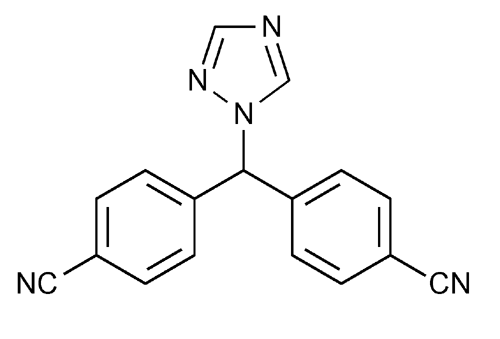Letrozole
Benzonitrile, 4,4¢-(1H-1,2,4-triazol-1-ylmethylene)bis-.
4,4¢-(1H-1,2,4-Triazol-1-ylmethylene)dibenzonitrile
» Letrozole contains not less than 98.0 percent and not more than 102.0 percent of C17H11N5, calculated on the anhydrous basis.
Packaging and storage—
Preserve in tight containers at controlled room temperature.
Identification—
B:
The retention time of the major peak in the chromatogram of the Assay preparation corresponds to that in the chromatogram of the Standard preparation, as obtained in the Assay.
Water, Method I  921
921 :
not more than 0.3%.
:
not more than 0.3%.
Residue on ignition  281
281 :
not more than 0.1%.
:
not more than 0.1%.
Heavy metals, Method II  231
231 :
0.001%.
:
0.001%.
Related compounds—
Solution A, Solution B, Mobile phase, and Diluent—
Prepare as directed in the Assay.
System suitability solution—
Dissolve accurately weighed quantities of USP Letrozole Related Compound A RS and USP Letrozole RS in Diluent to obtain a solution having known concentrations of about 2 µg per mL and 10 µg per mL, respectively.
Test solution—
Transfer about 25 mg of Letrozole, accurately weighed, to a 250-mL volumetric flask, dissolve in 75 mL of acetonitrile, dilute with water to volume, and mix.
Reference solution—
Transfer 5.0 mL of the Test solution to a 50-mL volumetric flask, and dilute with Diluent to volume. Transfer 5.0 mL of the solution so obtained to a 50-mL volumetric flask, dilute with Diluent to volume, and mix.
Chromatographic system—
Prepare as directed in the Assay. Chromatograph the System suitability solution, and record the peak responses as directed for Procedure: the relative retention times are about 0.68 for letrozole related compound A and 1.0 for letrozole; and the resolution, R, between letrozole related compound A and letrozole is not less than 1.5. Chromatograph the Reference solution, and record the peak responses as directed for Procedure: the relative standard deviation for replicate injections is not more than 10.0%.
Procedure—
[note—4,4¢,4¢¢-Methylidenetrisbenzonitrile may be present; its relative retention time is about 1.9.] Separately inject equal volumes (about 15 µL) of the Test solution and the Reference solution into the chromatograph, record the chromatograms, and measure the areas for the major peaks. Calculate the percentage of each impurity in the portion of Letrozole taken by the formula:
ri / rR,
in which ri is the peak response of letrozole related compound A, 4,4¢,4¢¢-methylidenetrisbenzonitrile, or any other impurity obtained from the Test solution; and rR is the peak response of letrozole obtained from the Reference solution: not more than 0.3% of letrozole related compound A is found; not more than 0.2% of 4,4¢,4¢¢-methylidenetrisbenzonitrile is found; not more than 0.1% of any other impurity is found; and not more than 0.3% of all other impurities is found.
Assay—
Solution A—
Use filtered and degassed water.
Solution B—
Use filtered and degassed acetonitrile.
Mobile phase—
Use variable mixtures of Solution A and Solution B as directed for Chromatographic system. Make adjustments if necessary (see System Suitability under Chromatography  621
621 ).
).
Diluent—
Prepare a filtered and degassed mixture of Solution A and Solution B (7:3).
Standard preparation—
Dissolve an accurately weighed quantity of USP Letrozole RS in Diluent, and dilute quantitatively, and stepwise if necessary, with Diluent to obtain a solution having a known concentration of about 10 µg per mL.
Assay preparation—
Transfer about 20 mg of Letrozole, accurately weighed, to a 100-mL volumetric flask. Dissolve in and dilute with Diluent to volume, and mix. Pipet 5.0 mL of this solution into a 100-mL volumetric flask, dilute with Diluent to volume, and mix.
Chromatographic system (see Chromatography  621
621 )—
The liquid chromatograph is equipped with a 230-nm detector and a 4.6-mm × 12.5-cm column that contains 5-µm packing L1. The flow rate is about 1.0 mL per minute. The chromatograph is programmed as follows.
)—
The liquid chromatograph is equipped with a 230-nm detector and a 4.6-mm × 12.5-cm column that contains 5-µm packing L1. The flow rate is about 1.0 mL per minute. The chromatograph is programmed as follows.
Chromatograph the Standard preparation, and record the peak responses as directed for Procedure: the tailing factor is between 0.8 and 1.5; and the relative standard deviation for replicate injections is not more than 2.0%.
| Time (minutes) |
Solution A
(%) |
Solution B
(%) |
Elution |
| 0 | 70 | 30 | equilibration |
| 0–25 | 70®30 | 30®70 | linear gradient |
Procedure—
Separately inject equal volumes (about 20 µL) of the Standard preparation and the Assay preparation into the chromatograph, record the chromatograms, and measure the areas for the major peaks. Calculate the quantity, in mg, of C17H11N5 in the portion of Letrozole taken by the formula:
2000C(rU / rS)
in which C is the concentration, in mg per mL, of USP Letrozole RS in the Standard preparation; and rU and rS are the peak responses obtained from the Assay preparation and the Standard preparation, respectively.
Auxiliary Information—
Please check for your question in the FAQs before contacting USP.
Chromatographic Column—
| Topic/Question | Contact | Expert Committee |
| Monograph | Feiwen Mao, M.S.
Scientist 1-301-816-8320 |
(MDOOD05) Monograph Development-Ophthalmics Oncologics and Dermatologicals |
| Reference Standards | Lili Wang, Technical Services Scientist 1-301-816-8129 RSTech@usp.org |
USP32–NF27 Page 2756
Pharmacopeial Forum: Volume No. 27(6) Page 3313
Chromatographic columns text is not derived from, and not part of, USP 32 or NF 27.
